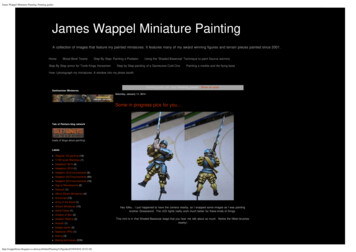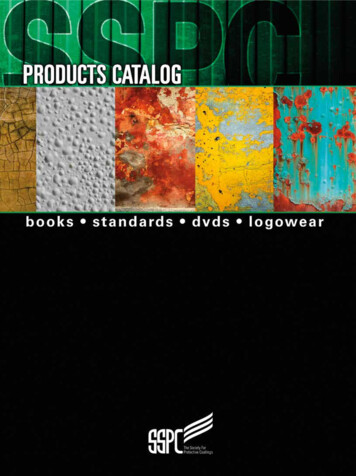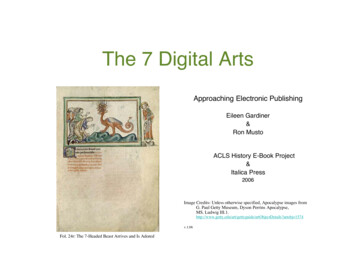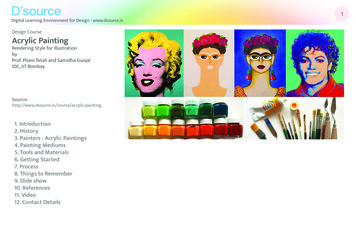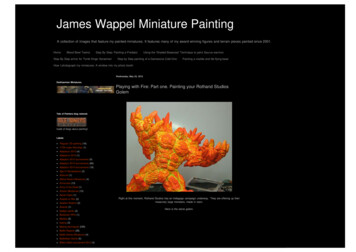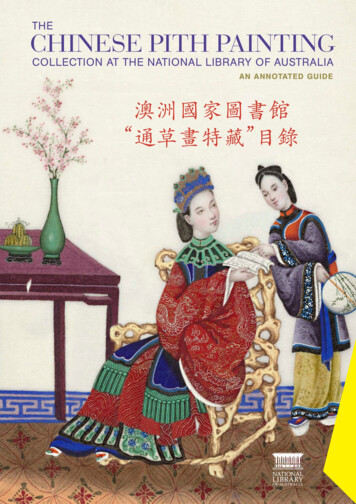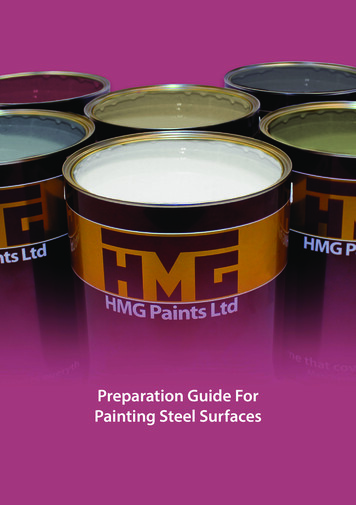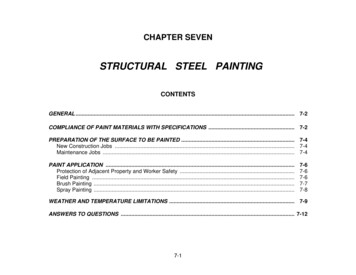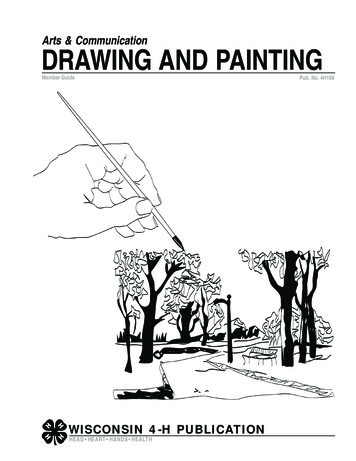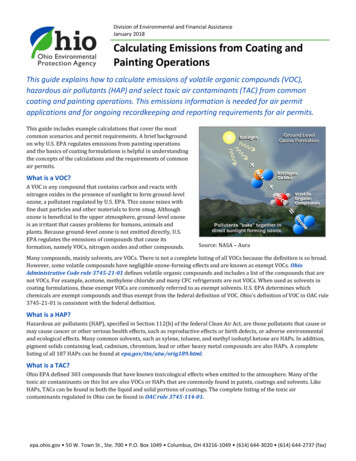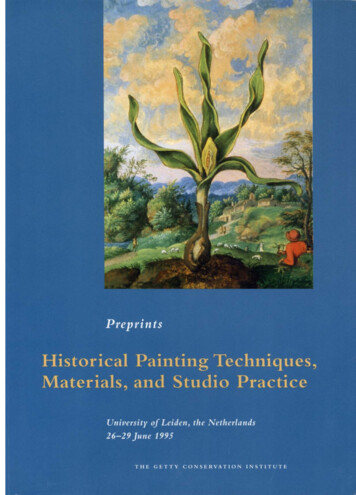
Transcription
Historical Painting Techniques,Materials, and Studio Practice
PUBLICATIONS COORDINATION: Dinah BerlandEDITING & PRODUCTION COORDINATION: Corinne LightweaverEDITORIAL CONSULTATION: Jo HillCOVER DESIGN: Jackie Gallagher-LangePRODUCTION & PRINTING: Allen Press, Inc., Lawrence, KansasSYMPOSIUM ORGANIZERS:Erma Hermens, Art History Institute of the University of LeidenMarja Peek, Central Research Laboratory for Objects of Art and Science,Amsterdam 1995 by The J. Paul Getty TrustAll rights reservedPrinted in the United States of AmericaISBN 0-89236-322-3The Getty Conservation Institute is committed to the preservation ofcultural heritage worldwide. The Institute seeks to advance scientiRcknowledge and professional practice and to raise public awareness ofconservation. Through research, training, documentation, exchange ofinformation, and ReId projects, the Institute addresses issues related tothe conservation of museum objects and archival collections,archaeological monuments and sites, and historic bUildings and cities.The Institute is an operating program of the J. Paul Getty Trust.COVER ILLUSTRATIONGherardo Cibo, "Colchico," folio 17r of Herbarium, ca. 1570. Courtesyof the British Library.FRONTISPIECEDetail from Jan Baptiste Collaert, Color Olivi, 1566-1628. AfterJohannes Stradanus. Courtesy of the Rijksmuseum-Stichting,Amsterdam.Library of Congress Cataloguing-in-Publication DataHistorical painting techniques, materials, and studio practice :preprints of a symposium [held at] University of Leiden, theNetherlands, 26-29 June 1995/ edited by Arie Wallert, ErmaHermens, and Marja Peek.p.cm.Includes bibliographical references.ISBN 0-89236-322-3 (pbk.)2. Artists' materials-1. Painting-Techniques-Congresses.-Congresses. 3. Polychromy-Congresses.1950-II. Hermens, Erma, 1958-ND1500.H57I. Wallert, Arie,. III. Peek, Marja, 1961-1995751' .09-dc2095-9805CIPSecond printing 1996iv
ContentsviiviiiForewordPreface1Leslie A. Carlyle, Beyond a Collection of Data: What We CanLearn from Documentary Sources on Artists' Materials andTechniques6Sylvana Barrett, Dusan C. Stulik,An Integrated Approach for theStudy of Painting Techniques12Helen Glanville, Varnish, Grounds, Viewing Distance, andLighting: Some Notes on Seventeenth-Century Italian PaintingTechnique20Ann Massing,30Sally A. Woodcock,From Books of Secrets to Encylopedias: PaintingTechniques in France between 1600 and 1800The Roberson Archive: Content andSignificance38Arie Wallert, Libro Secondo de Diversi Colori e Sise da Mettere aA Fifteenth-Century Technical Treatise on ManUSCriptIlluminationOro:48Erma Hermens, A Seventeenth-Century Italian Treatise onMiniature Painting and Its Author(s)58Beate Federspiel,65Renate Woudhuysen-Keller,70Questions about Medieval Gesso GroundsAspects of Painting Technique in theUse of Verdigris and Copper ResinateJosephine A. Darrah,Connections and Coincidences: ThreePigments78Kate I. Duffy, Jacki A. Elgar, An Investigation of Palette and ColorNotations Used to Create a Set of Tibetan Thangkas85Zuzana Skalova, New Evidence for the Medieval Production ofIcons in the Nile Valley91Helen C. Howard, Techniques of the Romanesque and Gothic WallPaintings in the Holy Sepulchre Chapel, Winchester Cathedral105Eddie Sinclair, The Polychromy of Exeter and SalisburyCathedrals: A Preliminary Comparison111Andrea Rothe,117Andrea Mantegna'sTechnicalA Note on EarlyUlrich Birkmaier, Arie Wallert, Andrea Rothe,Examinations of Titian's VenusItalian Oil Painting Technique127Adoration of the Magiand Adonis:Gerard David'sEvidence for Workshop ParticipationCatherine A. Metzger, Barbara H. Berrie,Anne Altarpiece:St.v
135Molly Faries, Christa Steinbuchel, and J. R. J. van Asperen deMaarten van Heemskerck and Jan van Scorel's HaarlemWorkshopBoer,140E. Melanie Gifford, Style and Technique in Dutch LandscapePainting in the 1620s148J rgen Wadum,Johannes Vermeer (1632-1675) and His Use ofPerspective155Ilze Poriete, Dace Choldere, A Technical Study of the Materialsand Methods Used by the Painters of the Latvian Churches in theSeventeenth Century158Melissa R. Katz,William Holman Hunt and the «Pre-RaphaeliteTechnique"166Jo Kirby, Ashok Roy,Paul Delaroche: A Case Study of AcademicPaintingvi176Painting Techniques and Materials of Turnerand Other British Artists 1775-1875186Stephen Hackney,191John R. Gayer,196Ernst van de Wetering, Reflections on the Relation betweenTechnique and Style: The Use of the Palette by the Seventeenth Century Painter204Index of ContributorsJoyce H. Townsend,Art for Art's Sake: The Materials andTechniques of James McNeill Whistler (1834-1903)Painting on a Photographic Substrate: NotesRegarding Materials and Techniques over the Past 100 Years
ForewordOne of the first events organized by the Getty Conservation Institute asit began its activities about ten years ago was a symposium on paintingsconservation. We felt at that time that our particular approach, based onmultiple disciplines looking at a single problem, could contribute signifi cantly to the field of conservation. Over the course of the past years wehave continued to develop in that direction and with that belief, so it isparticularly appropriate to see these important preprints come to light forthe University of Leiden's symposium.The history of painting techniques is by nature a multidiSCiplinary areaof study, combining research in science, conservation, and art history aswell as specific expertise in paintings. Members of each one of these pro fessions bring to the area their own detailed knowledge in artists' materials,techniques, or methods, whether it be information specific to pigments,binding media, signature style, or archival research.The field of history of painting techniques has been evolving very rapidlyin recent years and opening enormous opportunities for further researchand connOisseurship, as this important group of papers demonstrates. Notonly scientific methods of examination but also bibliographical and archivalresearch are making significant contributions.The authors of these preprints bring a wide array of expert knowledgeas well as many fresh points of view that are certain to provoke seriousquestions and debate. The editors-Arie Wallert, Erma Hermens, andMarja Peek-have assembled this volume with a most inSightful approachand focus. So it is with a great deal of satisfaction and pleasure that wepresent these papers for the study, and enjoyment, of a fascinating andchallenging field.Miguel Angel Corzo, DirectorThe Getty Conservation Institutevii
PrefaceThis volume of preprints, prepared for an international symposium onHistorical Painting Techniques, Materials, and Studio Practice at the Uni versity of Leiden, the Netherlands, 26-29 June 1995, contains the resultsof work on historical painting techniques from all parts of the world. Thesuggestion to organize such a meeting was raised during the symposiumon the Technology of Art Works from the Central European Region or ganized by the Archives of Art Technology in Prague in 1993. The Praguesymposium emphasized Czech painters and their techniques. To broadenthe scope of attention, Erma Hermens of the Art History Institute of theUniversity of Leiden and Marja Peek of the Art Historical Department ofthe Central Research Laboratory for Objects of Art and Science in Am sterdam took on the task of organizing a second meeting in Leiden.The purpose of the symposium and this publication is to promote agreater understanding of the changing boundaries and interaction betweenart historians, conservators, and conservation scientists working in the fieldsof historical painting techniques-including wall paintings and poly chrome sculpture-painting materials, and studio practice.In recent years, there has been an increasing interest in historical paint ing techniques. The study of the painting techniques and materials usedthroughout history and in various cultures is by nature an interdisciplinaryexercise. In the past such studies were sometimes conducted with littleinteraction between art historians, conservators, materials scientists, andhistorians of science, because each discipline tends to present the resultsof its studies to different forums. This volume aims to present differentapproaches to the study of historical painting techniques in the hope thatit will encourage cooperation among these various disciplines.Information about painting techniques can be gained in a variety ofways, including the chemical or physical analyses of the materials foundin the paintings. Analyses of a large number of paintings attributed tocertain regions, schools, workshops, or individual masters can contributeto a history of painting techniques. Analytical results can also help arthistorians assess attributions and can support or reject their hypotheses.The analysts, however, need the art historians to inform them about thestylistic idiosyncrasies and significance of those schools, workshops, or mas ters.It is often rewarding to see what artists have said about their own workand to study their written sources on painting techniques. This kind ofinformation has come down to us in diaries, such as Neri di Bicci's Ricor danze; in painting handbooks such as Cennini's Libra dell'Arte, in anony mous recipe books; and even in model books, such as Stephan Schriber'sMusterbuch. These recipe books tell scientists what substances to look forin analysis. Both scientific and art historical information help us understandthe significance of sometimes rather obscure recipes and tell us whetherthe methods and materials described are common or exceptional for theparticular period. Today it is not unusual to find information from historicalsources incorporated in the examination of individual paintings.viii
The discussions in this volume present historical painting techniquesfrom a variety of professional perspectives. With its wide range of topicsand approaches to the study of historical painting techniques, this publi cation is presented in the hope that it will provide an impetus for furtherstudies that involve material science, art history, conservation, archaeo metry, and the history of science. We also hope it will be one in a seriesof such interdisciplinary and collaborative volumes.In addition to thanking all the colleagues at our institutions who helpedus with advice and expertise, we also would like to acknowledge theinvaluable work and support of several individuals in particular. MiguelAngel Corzo, director of the Getty Conservation Institute, immediatelysupported the idea to publish the presentations of the symposium andgenerously provided his time and support in the production of the presentvolume. Agnes Grafin Ballestrem, director of the Central Research Lab oratory for Objects of Art and Science in Amsterdam, and A. W. A. Bos chloo of the Art History Institute of the University of Leiden supportedthe entire project from its initial stages and advised us during the editorialprocess. Corinne Lightweaver and Jo Hill, independent editorial consul tants, carried out invaluable work on the manuscripts, assisted by Joy Hart nett. In the preparation of these preprints for publication, we also wish tothank Dinah Berland, publications coordinator, the Getty ConservationInstitute.Arie WallertThe Getty Conservation InstituteErma HermensArt History Institute of the University of LeidenMarya PeekCentral Research Laboratory for Objects of Art and Science, Amsterdamix
Plate l a, left. Bartolomeo Vivarini, active 145 149 1 ,Saint Peter, 1490. Tempera o n partel. From Polyptychwith Saint James the Greater, The Virgin and Childand Other Saints. The]. Paul Getty Museum, Malibu(7 1 . PB. 30).Plate 1 b, above. Detail from Vivarini's Saint Peter, show ing clearly visible, individual brush strokes.
Plate 2a, above right. Attributed to Raphael, 1483- 1 520, Por trait of a Young Man, 1 505. Oil on panel. The J. Paul GettyMuseum, Malibu (78. PB. 3 64}.Plate 2b, right. Detailfrom Portrait of a Young Man, illustratingthe clear, luminous color of the transparent oil techniques.
Plate 3a, above. Peter PaulRubens, 1 5 7 7- 1 640, TheVirgin as the Woman ofthe Apocalypse, 1 62 3 .Oil o n wood. The]. PaulGetty Muse um, Malibu(85.PB. 146) .Plate 3b, right. Detail fromThe Virgin as the Wom an of the Apocalypse, il lustrating the use of impastowhite under highlightedareas.
Plate 4a, above. Jacques Louis David, 1 748- 1 825,The Sisters Zenalde andCharlotteBonaparte,1 82 1 . Oil on canvas. TheJ. Pa ul Getty Museum,Malibu (86. PA . 740) .Plate 4b, rig ht. Detail JromThe Sisters Zenalde andCharlotte Bonaparte, il lustrating the imperceptibleshift from dark to lig ht tonesresu lting from physicallyblending pigments on thesuiface
Plate 5, hft. Colorjading tests, 1 83 71 878. Fitzwilliam Museum, UnilJwil)'of Cambridge.Plate 6, above. Pigmelll {(llilailicrs: j)"illlbladder to collapsible Illbe. Fil':'lI'illi,1/1/Museum, Universil), of Clll//Jri(! c.
Plate 7a, above. ValerioMariana da Pesaro, Battleof San Fabiano, 1 6 1 81 620. Photograph by E.Buzzegoli, Laboratorio diRestauro. Courtesy of theUjfizi Gallery, Florence.Plate 7b, right. Detailfrom Battle of San Fabi ano, 1 6 1 8- 1 620, show ing the landscape in thebackground built up withseveral transparent washesof color. Photograph by E.Buzzegoli, Laboratorio diRestauro . Courtesy of theUjfizi Gallery, Florence.
Plate 8. Gherardo Cibo, "Colchico, " from Herbarium (MS ADD 22333), jolio 1 7r, ca.1 570. Courtesy oj the British Library.
Plate 9 . Marco Palmezzano, Mystic Marriage of Saint Catherine, signed and dated1 53 7. Photograph by Christopher Hurst. Private collection.
Plate 1 0. Detail from MarcoPalmezzano's Mystic Mar riage of Saint Catherine,showing green glaze dabbed onSt. Catherine's garment. A reashown measures approx. 3 X4 cm. Photograph by Chris topher Hurst. Private collec tion.Plate 1 1 . Cross section from PalmezzarLO 's Mystic Mar riage of Saint Catherine, showing of the green baldach
Art History Institute of the University of Leiden Marya Peek Central Research Laboratory for Objects of Art and Science, Amsterdam ix . Plate la, left. Bartolomeo Vi varini, active 145 149 1, Saint Peter, 1490. Te mpera on partel. From Polyptych with Saint James the Greater, The Virgin and Child and Other Saints. Th e]. Pa ul Getty Museum, Malibu (71.PB.30). Plate 1 b, above. Detail fr om Vi .
